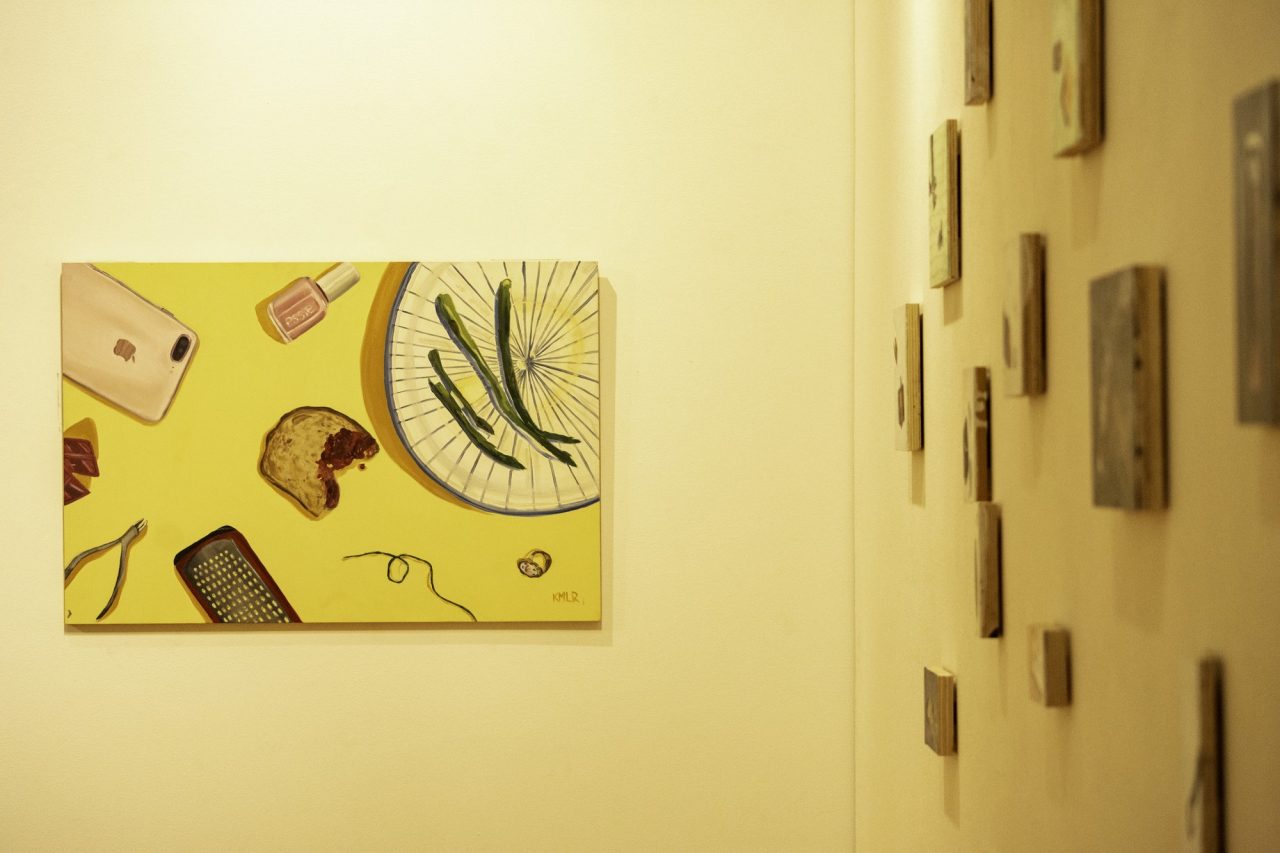Photo by Martina Almeida
Trinity’s annual student gallery exhibition, the Mini, opens this Friday in the Neirdorff Gallery in the Dicke-Smith art building. The exhibit consists of pieces from three groups of collaborating student artists, a feature that started they instituted this year.
Each group focuses on one theme around which to center their pieces. One group discusses violence, another looks a power, and the third looks at gender. These artists use media such as photography, collage and fashion design to explain and display the complexity of these ideas.
To put together the show, each group of artists must collaboratively construct and send a proposal to the gallery.
“Sometimes you have your pieces made beforehand, sometimes you don’t,” said senior art major Quinn Bender, whose art is on display in the show. “So you just write out your idea, the dimensions, influences, what you think your piece is going to end up looking like.”
After the groups send their proposals to the gallery, a committee reviews the proposals and chooses which pieces to include in the exhibition. The art department facilitates the process of artist recruitment and review of proposals, but the artists collaborate the most with the gallery manager throughout the construction and display of the exhibition.
However, this year the artists are putting on their exhibition without a gallery manager.
“[The gallery manager] would help us make the posters, they send information out to people interested in the art world around San Antonio, or in the school,” Bender said. “It’s a lot of stuff that we don’t know how to do, but we’re learning. It’s good that there’s nine of us so we can split up the work.”
One group of artists, consisting of seniors Alex Motter and Catherine Phillips, discusses power dynamics through their art.
The two are taking traditional portrait-style photographs of upper-class families and changing the photographs to including minorities and individuals in roles that may be unexpected.
“I had a vision of taking the traditional view of upper-class aristocratic families, which is very patriarchal, very heteronormative and very white and subverting and changing that image,” Motter said. “We are addressing this really complex nexus of race, gender, class and sexuality, but through a lens that is more familiar. It’s what you’d expect, but not exactly what you’d expect. We are trying to get people to question why they perceive a certain type of person when they think of royalty.”
The largest group of artists in the exhibition is taking on the topic of gun violence.
With contributions from seniors Bender, Dinda Lehrmann, Gage Brown, Katie Warford and Alexus Jimenez, the group has a variety of perspectives from which to draw.
“We want to focus on the victims of gun violence rather than the guns themselves, or the political issue of it, but rather focusing on how mainstream the idea of mass shootings has become,” Bender said. “We all come from different backgrounds and have different mindsets, but we are all concerned with the same issue. We wanted to make sure people are talking about this issue.”
Bender’s contribution to the exhibit is mostly photography, her preferred medium of art.
“With photography, I just understand it,” Bender said. “I just gravitate towards it naturally. I like that you can take a picture of something and save it forever and the thing you took a picture of might never exist again, but you still have it, that piece of reality.”
The final group of artists has chosen the topic of gender for their portion of the exhibition. Seniors Raquel Belden and Kristina Reinis take different approaches to this topic but share in the subject matter.
“Our work deals with fragmentation and being a young woman in a transition in your life,” Belden said. “I’m talking about the experience of being a woman and how that experience is so regulated and how the female voice is so silent but the female image is so dominant.”
Belden is using her preferred medium of collage to emphasize this particular theme.
“[We are trying to show] how the parameters around womanhood are arbitrary and you can break them down, which is what I’m literally doing,” Belden said. “I am taking images from fashion magazines, cutting them up and making them into these weird, distorted and almost grotesque figures.”
Belden is taking advantage of her medium to best express the issues of gender that she and her groupmate are displaying.
“I’m taking these images that we structure our whole life around, pulling them apart, putting them back together, ruining them a little bit, adding new things to them,” Belden said. “I’m showing how easily the female image can be manipulated for whatever purpose you’re trying to achieve.”
Although each group is focusing on a different topic, their individual exhibits come together in a larger idea.
“Each group is encouraging people to see these heavily saturated projects,” Belden said. “[We encourage people] to consider these projects in a newfound context. All three groups are striving to create that dialogue and engage the viewer.”
Furthermore, the exhibit emphasizes the artists’ individualism and collaboration, according to Motter.
“It’s really focused on art in conversation because, within each respective style, each artist is bringing something,” Motter said. “It’s one cohesive piece with individual elements incorporated.”
The Mini’s opening reception is from 5–7 p.m on Nov. 15, but the exhibition will be open until Dec. 7.
“We have a lot of really interesting things to say, and in a time when we as a society have become more politicized, and a lot of the topics we’re talking about are big in the news,” Motter said. “It’s something worth seeing and worth experiencing.”







